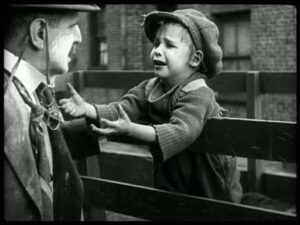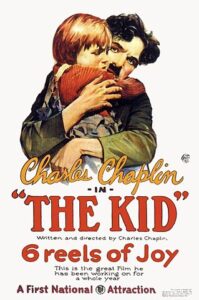Scott Winfield Sublett
Screenwriter Herman Mankiewicz said of Charlie Chaplin, “If people don’t sit at Chaplin’s feet, he goes out and stands where they’re sitting.” Of course, Mankiewicz might have been a bit envious. He, after all, wrote only one masterpiece, and that one not entirely solo (despite the confabulations of Mank director David Fincher). Sir Charles Spencer Chaplin, meanwhile, wrote, directed, pantomimed, and often composed the poignant scores for a dozen masterpieces. The Kid, his first feature-length film as a director, was the second-biggest hit of 1921 — the same year Prince Philip was born. Those are just two of the reasons 1921 was a notable year, a third being that the not-really-Spanish Spanish Flu was terminó.
Chaplin was in his early thirties when he directed The Kid. The Little Tramp, with his penguin gait and big, kohl-rimmed eyes, was already the most famous figure in the world: a scrounger in tattered, ill-fitting, formal attire, with little gentlemanly affectations, like keeping his nasty, half-smoked stogies in a tin box that he handles like a silver cigar case from Dunhill. The Tramp’s affectations seem not pretentious, but rather sublimely, touchingly human. He chooses to be civilized in an uncivil environment: the Little Tramp is a creature of the slums — like Charlie himself, with his loving-but-deranged mother, and childhood stints in Dickensian workhouses.

Mack Sennett of Keystone Kops fame, who discovered Chaplin and is acknowledged as the inventor of film comedy, was pretty much right when he said that there are only two gags in the world: mistaken identity and collapse of dignity. The latter concept requires little explication: haughty banker slips on banana peel and lands on keister. But mistaken identity covers a lot of ground — really, it means any misperception or misrepresentation of the self or others: pretending or being fooled or wearing a disguise. The Little Tramp’s delicately refined demeanor is a case of mistaken identity — he’s mistaken himself for a gentleman, or is trying to get others to do so; probably both. The irony is that the Little Tramp has, inside him, at least sometimes, the nobility of spirit of a true gentleman, which makes the joke softer and more beautiful.
Chaplin was famous for applying mistaken identity to objects — everyone knows the dinner: rolls ‘mistaken’ for dancing feet in The Gold Rush, and elsewhere in that picture is the old boot he takes for a gourmet meal. Picasso (a Chaplin fan), did the same sort of thing with his 1942 Bull’s Head made from a bicycle seat and a handlebar. There’s some of that comedy-of-objects stuff in The Kid, as when he uses a coffee pot as a baby bottle, but at this point in his career much of the comedy is still boisterous slapstick, which is fine because the slapstick is still funny today and comes out of sharply drawn character.
Almost everyone has seen clips from The Kid, but for those who haven’t watched the whole movie, the plot is elegantly simple. A young woman whose sin is motherhood (unwed), walks out of a scruffy charity hospital carrying a newborn. Chaplin gives us a brief peek at the absent father — deliciously enough, he’s a painter, showing a possible buyer one of his works. When the painter tosses a photo of the mother into the fireplace, we know he’s out of the baby’s picture — as was Chaplin’s own long-gone father.
Wandering the streets alone, the mother impulsively abandons her newborn in the back seat of a shiny limousine, with a crumpled note: “Please love and care for this orphan child.” She quickly changes her mind, but too late: crooks have stolen the car and dumped the worthless little bundle of humanity in an alley. There, it falls into the possession of the Little Tramp, and after multiple (hilarious) attempts to dump it, the Tramp is forced to take it home.

Cut to the boy, now five, and his doting father sharing a contented domestic routine in their cozy hovel. Daddy heaps comically exaggerated mountains of food onto their plates and we know the boy will never be hungry, or unloved, and what else matters? (Notice how often the specter of starvation, which Chaplin certainly experienced as a boy, turns up in his movies.)
Also, they’re grifters. The scamp (Jackie Coogan, natural and adorable in his first role — it made him an enormous child star) hurls rocks through windows, and Daddy shows up with his glazing kit to replace the glass. Just as the movie got us rooting for the unwed mother, we pull for the scamming father and son, and we’re scared of that damned cop who seems to be around every corner.
Meanwhile, the mother (Chaplin’s lover Edna Purviance, to whom his film company would pay a small stipend until her death in 1958) has suddenly become a famous actress. Call that improbable, but then, so was Chaplin’s own recent, precipitous rise from rags to riches. In her charity work in the slums, the mother-turned-actress runs across the kid, but doesn’t realize this boy is the one she gave up.
When the kid falls ill, a nosy, officious doctor calls the authorities and they come to get him. The shot of Jackie Coogan, in the back of an open truck like an animal being hauled to slaughter, sobbing for his papa, straining arms outstretched, is the film’s highest pathos, and one of the best-known shots in film history. Fortunately, the note the mother tucked into the baby’s swaddle falls into the right hands at the right moment and that’s all we’ll say about the denouement.
100 years after the release of The Kid, the thing that feels most urgently relevant is the relationship between the slum-dwellers and the law. The Kid would cement Chaplin’s reputation for social consciousness, but you seldom catch it being didactic, except a little in the inter-titles. I’m not knocking didactic (and nowadays you’d better not if you know what’s good for your career in the arts), but it’s nice that the film isn’t preachy in the way Chaplin would sometimes get later in his career, with the party-line Marxism of Modern Times (still not good enough for Stalin), or the moralizing curtain speech that ends The Great Dictator. Paulette Goddard, Chaplin’s leading lady in Modern Times (and third wife) said that, “everyone over-intellectualized Charlie’s work and consequently he became self-conscious. It harmed him, I think.” Chaplin’s friend and rival Buster Keaton said much the same thing. The Kid, though, retains a purity in which comedy, pathos and social commentary are integrated into a seemingly simple whole that’s all story all the time. You never feel that the message is stepping on the story. It’s an imitation of life, not a lecture. It dramatizes that underclass lives matter and does so from their point of view.

It’s often said Chaplin was a great satirist, but that doesn’t seem quite right in the case of The Kid. The tone is not satirical in the sense of Shaw, Molière, or Comedy of Manners — it’s not cool headed, clever or arch. And of course, it’s a silent movie, so there are no memorable aphorisms. In fact, what keeps it fresh 100 years on is that it isn’t detached and superior. The artist doesn’t feel outside or above the class system he tweaks. The ruined finery in which he’s arrayed doesn’t connote status so much as a hunger for even a cold, leftover piece of the economic pie. If satire often concentrates on the cruel antics of high-handed hoity-toities, the social consciousness of Chaplin’s The Kid lives in the dirt with the victims. That doesn’t make Chaplin better than the great satirists of the theatre, it doesn’t even make him funnier, but it made him literally the most popular entertainer in the world, yet also a favorite of geniuses like Beckett and Brecht. He encompassed everything human, all the dichotomies — generosity and greed, kindness and revenge, the base and the noble. He was us.

Beautiful articulate insightful piece, Scott
While we respect people’s right not to leave an email, a name would be desirable and show respect in its turn.